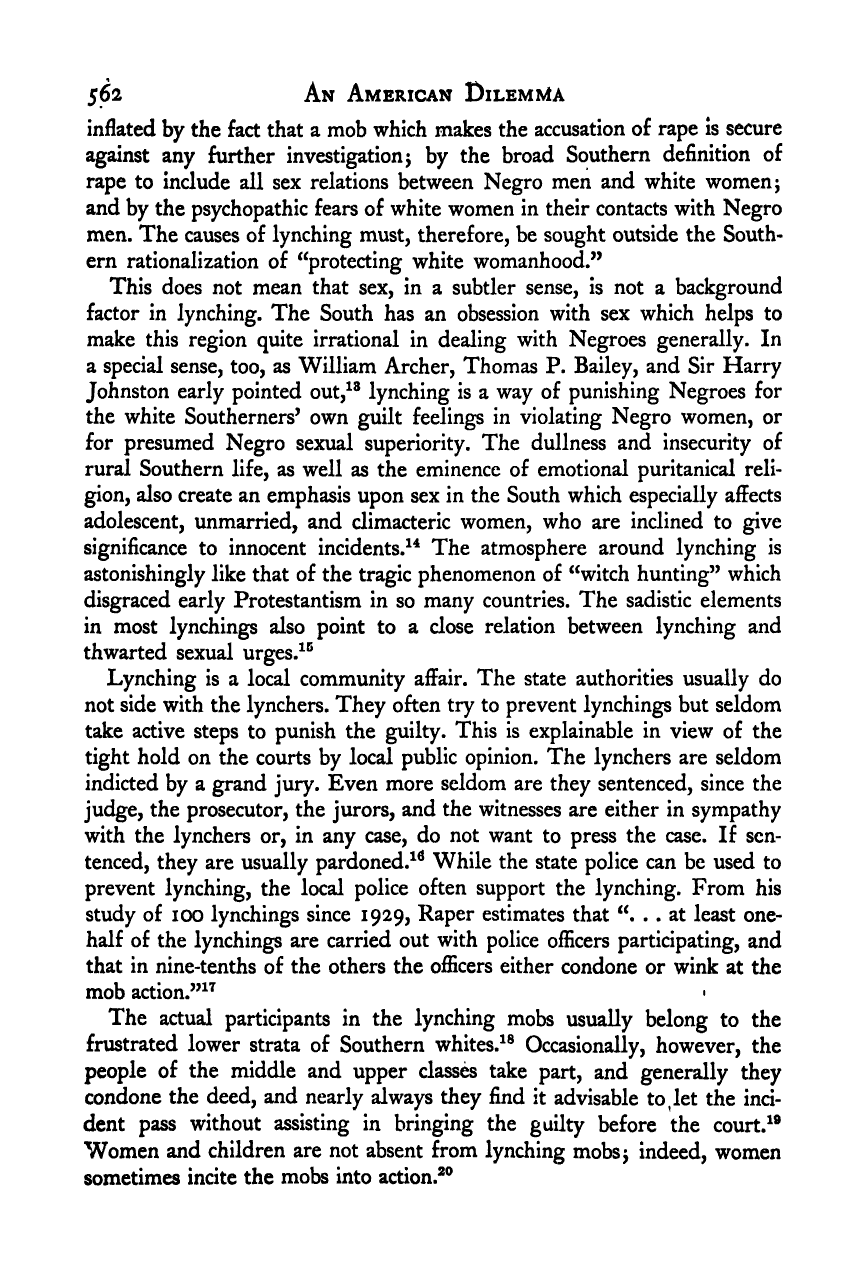Note: Gunnar Myrdal died in 1987, less than 70 years ago. Therefore, this work is protected by copyright, restricting your legal rights to reproduce it. However, you are welcome to view it on screen, as you do now. Read more about copyright.
Full resolution (TIFF) - On this page / på denna sida - VI. Justice - 27. Violence and Intimidation - 2. Lynching

<< prev. page << föreg. sida << >> nästa sida >> next page >>
Below is the raw OCR text
from the above scanned image.
Do you see an error? Proofread the page now!
Här nedan syns maskintolkade texten från faksimilbilden ovan.
Ser du något fel? Korrekturläs sidan nu!
This page has never been proofread. / Denna sida har aldrig korrekturlästs.
562 An American Dilemma
inflated by the fact that a mob which makes the accusation of rape is secure
against any further investigation j by the broad Southern definition of
rape to include all sex relations between Negro men and white women;
and by the psychopathic fears of white women in their contacts with Negro
men. The causes of lynching must, therefore, be sought outside the South-
ern rationalization of ^‘protecting white womanhood.”
This does not mean that sex, in a subtler sense, is not a background
factor in lynching. The South has an obsession with sex which helps to
make this region quite irrational in dealing with Negroes generally. In
a special sense, too, as William Archer, Thomas P. Bailey, and Sir Harry
Johnston early pointed out,^® lynching is a way of punishing Negroes for
the white Southerners’ own guilt feelings in violating Negro women, or
for presumed Negro sexual superiority. The dullness and insecurity of
rural Southern life, as well as the eminence of emotional puritanical reli-
gion, also create an emphasis upon sex in the South which especially affects
adolescent, unmarried, and climacteric women, who are inclined to give
significance to innocent Incidents.^^ The atmosphere around lynching is
astonishingly like that of the tragic phenomenon of “witch hunting” which
disgraced early Protestantism in so many countries. The sadistic elements
in most lynchings also point to a dose relation between lynching and
thwarted sexual urges.^°
Lynching is a local community affair. The state authorities usually do
not side with the lynchers. They often try to prevent lynchings but seldom
take active steps to punish the guilty. This is explainable in view of the
tight hold on the courts by local public opinion. The lynchers are seldom
indicted by a grand jury. Even more seldom are they sentenced, since the
judge, the prosecutor, the jurors, and the witnesses are either in sympathy
with the lynchers or, in any case, do not want to press the case. If sen-
tenced, they are usually pardoned.^^ While the state police can be used to
prevent lynching, the local police often support the lynching. From his
study of 100 lynchings since 1929, Raper estimates that “. . . at least one-
half of the lynchings are carried out with police officers participating, and
that in nine-tenths of the others the officers either condone or wink at the
mob action.’”*^ •
The actual participants in the lynching mobs usually belong to the
frustrated lower strata of Southern whites.^® Occasionally, however, the
people of the middle and upper classes take part, and generally they
condone the deed, and nearly always they find it advisable to, let the inci-
dent pass without assisting in bringing the guilty before the court.^®
Women and children are not absent from lynching mobs; indeed, women
sometimes incite the mobs into action.®®
<< prev. page << föreg. sida << >> nästa sida >> next page >>